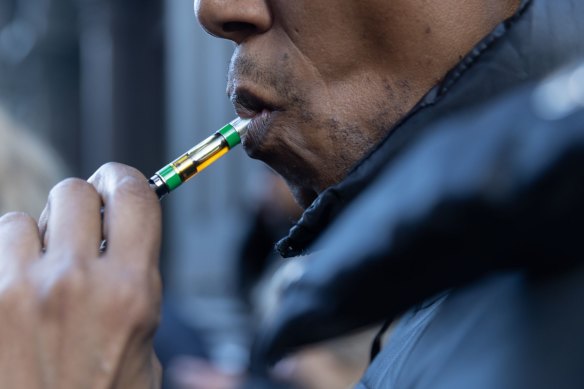- Exclusive
- Politics
- Federal
- Smoking & vaping
This was published 1 year ago
A million new GP visits needed for prescription vape reforms: report
About 450,000 more Australians are expected to seek out prescriptions for nicotine vapes each year, which will require almost a million new GP visits, according to newly released Health Department analysis that backs the government’s world-first vape reforms.
But young people could turn to tobacco if the new regime is too cumbersome and the black market could keep flourishing, the analysis said, as it flagged that existing barriers people face seeing a GP – such as low bulk-billing rates, high gap fees and regional health deserts – would also apply to those seeking a vaping script.

It’s estimated the reforms will cost consumers $52.1 million a year in GP and pharmacy visits.Credit: Marija Ercegovac
Fresh detail contained in an impact analysis of Australia’s vape reforms also warns that consumers could be paying a lot more for vapes under the new regime, with estimates people will fork out up to $150 for a refillable vaping device from the pharmacy. Only mint, menthol and nicotine flavours will be allowed.
It will be a major change from the current black market, estimated to be worth well over $400 million annually, which sells single-use products from China at convenience stores and online for between $20 and $40 each, in flavours that range from mango to cotton candy.
The success of Health Minister Mark Butler’s world-leading crackdown on vaping will rely on those imports being quashed and people pursuing the medical vaping pathway instead.
Busy promoting the newly introduced vaping import ban on January 2, Butler said the government was “obviously alive to any potential for people to move from vaping to cigarettes. That’s why in addition to the strong action we are taking on vaping we are also taking very strong action against cigarettes.”
Only about 70,000 of the country’s 1.3 million vapers currently use a doctor’s prescription.
The Health Department analysis assumes 450,000 of them will seek out a prescription when illicit sales are limited under the new regime, although that number would diminish over time.
The costings assume people will go to the GP for a script twice a year, and visit the chemist every month. Butler’s reforms would cost consumers $52.1 million a year in GP and pharmacy visits, and up to $67.5 million on vaping products.
The Health Department said a total regulatory burden of about $60 million would be justified if just 200 individuals avoided taking up tobacco as a result. “In balancing economic impact against public health outcomes, public health must be given more weight,” the analysis said.
But it also warned of risks. “Fears that extra regulation may incentivise growth in the black market for nicotine vapes must also be acknowledged ... This is a legitimate risk as tighter regulation will often raise the risk of black-market sales,” it said.
Several factors could threaten the medical model and drive people to tobacco: there could be insufficient access to medical vapes if suppliers exit the market under the new compliance burden, or if not enough doctors and pharmacies decide to participate in prescribing and dispensing vapes.
Consumers would also seek to evade the medical model if it was too restrictive in limiting the range of vapes available, while costs could go up if pharmacies chose to exploit their monopoly on supply.
Economic consequences would also flow to the retail sector, with all vape shops in Australia expected to close. The forecasts say each specialised vaping business – of which there are about 205 – would lose about $500,000 and two to three staff members would lose their job.
But the crackdown was judged as the best way to meet the public health goal of reducing vaping rates among young Australians, who have been using the devices at rising rates over the past three years. The analysis said risks would be mitigated in two main ways: strong education campaigns about the harms of vaping and nationally co-ordinated enforcement at the border.
The document reveals the government considered the merits of a consumer model, under which vapes were sold to over-18s over the counter as cigarettes are. That model, which is in place in much of Europe, the US and New Zealand, was advocated by retail lobbyists but lashed by the public health sector.
The document said consumers would have benefited through greater personal choice and saving money from doctors’ visits. People would also have been able to buy vapes from shops knowing they were of a higher quality.
The consumer model would also spare doctors the cost of prescribing vapes, and pharmacies from dispensing them. The small number of doctors now prescribing vapes would save $1.14 million and 140,000 visits a year, while the retail vaping sector would prosper.
But that option would not achieve the government’s aim of bringing down youth vaping rates. Rather, it would normalise recreational vaping, contradict public health messaging and kill off the emerging market for therapeutic products.
“There would be little or no perceived benefit for any company wishing to register vapes as therapeutic goods. Given this, the social costs from any increase in vaping far outweigh a reduction in economic and regulatory costs,” the analysis said.
The government also probed a stricter option, under which the Therapeutic Goods Administration would have to approve vape products for quality and safety before they were available at pharmacies.
While it was deemed the best option from a public health perspective, the analysis said it “would likely result in total failure of the therapeutic vaping market” because it could take years for products to be developed and approved, which manufacturers were unlikely to consider commercially viable.

A refillable prescription vape could cost around $150. Credit: Bloomberg
The analysis said the success of the chosen model would rely on the Royal Australian College of General Practitioners making sure doctors were willing to prescribe vapes – something they have been reluctant to do in the past.
The college updated its guidance to doctors last month to say “it may be reasonable” to recommend nicotine vape products when other smoking cessation options had failed.
The college’s smoking cessation chair, Nick Zwar, said it would take time for doctors to adjust to the new regime.
“We don’t know to what extent this group of people [vapers] will come and see their doctor,” he said.
“If these regulations are more effective, there may be more of a demand and I think GPs will respond to that. Not all will want to get involved, but I do think there will be more people wanting help in this regard.”
A spokeswoman for Butler said the government recognised that health practitioners would play an important role in supporting people to quit smoking and vaping.
The Health Department analysis said the reforms would be a success if by mid-2026 prescriptions increased and vaping rates were significantly reduced, especially among young people.
Cut through the noise of federal politics with news, views and expert analysis. Subscribers can sign up to our weekly Inside Politics newsletter.